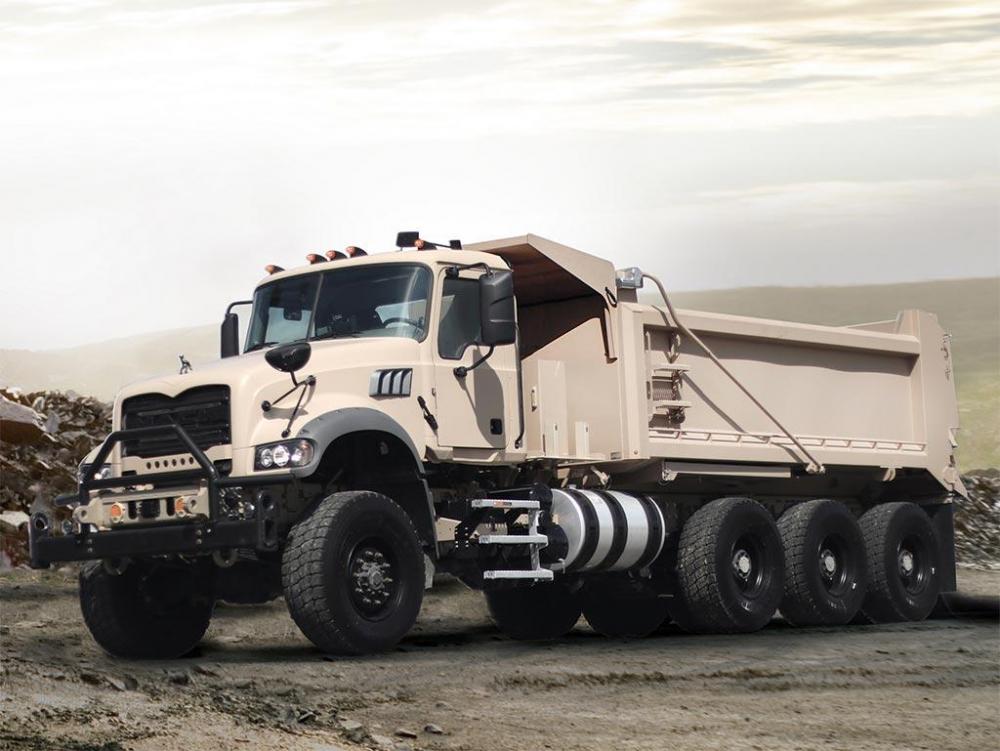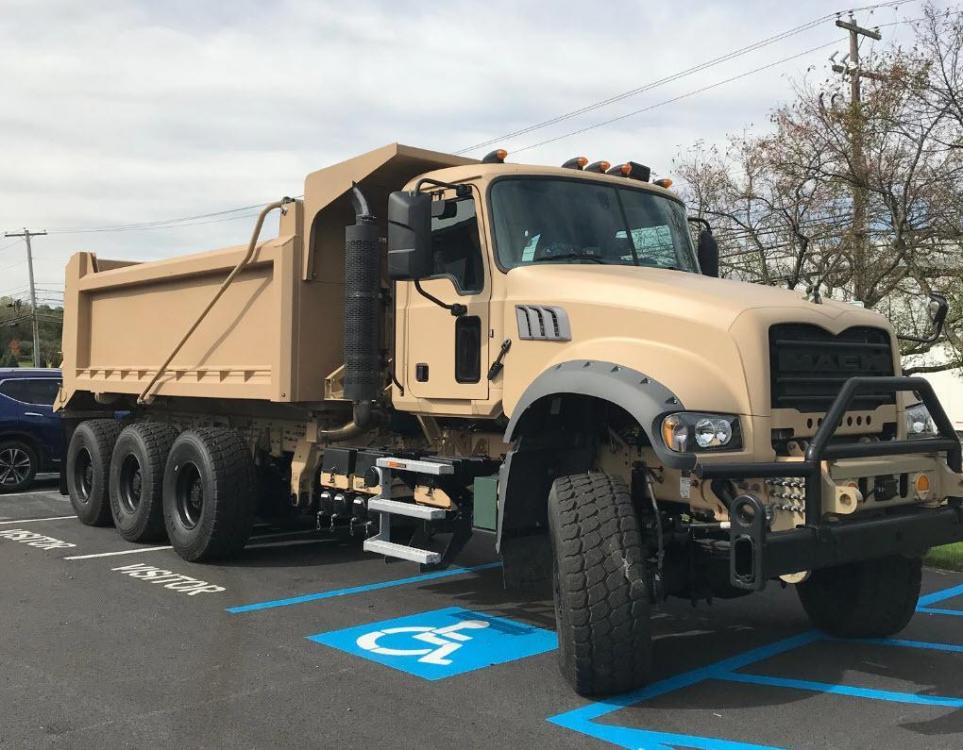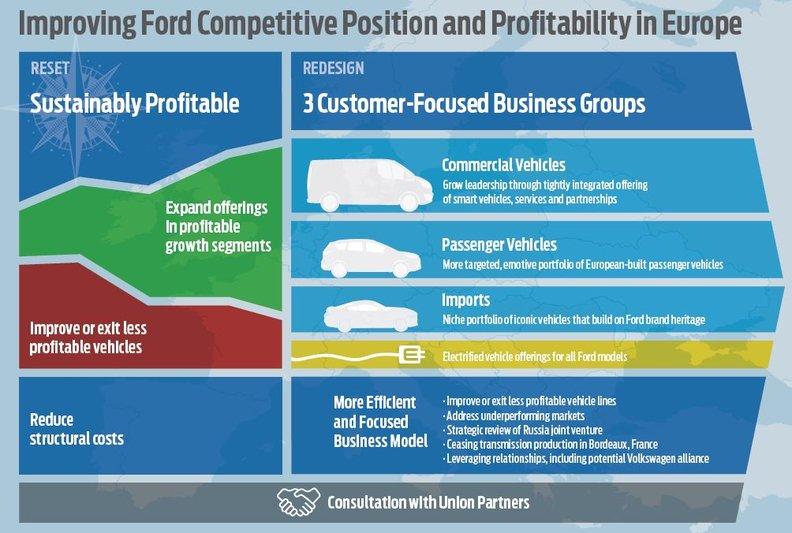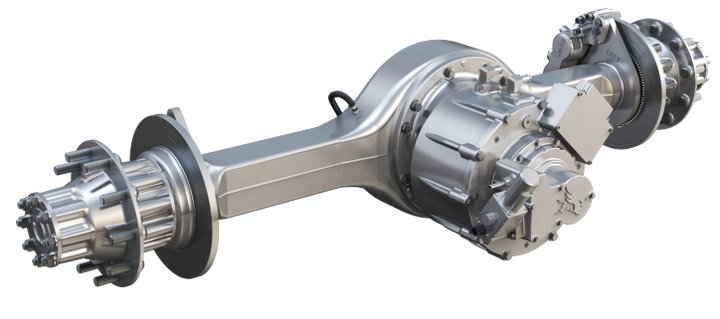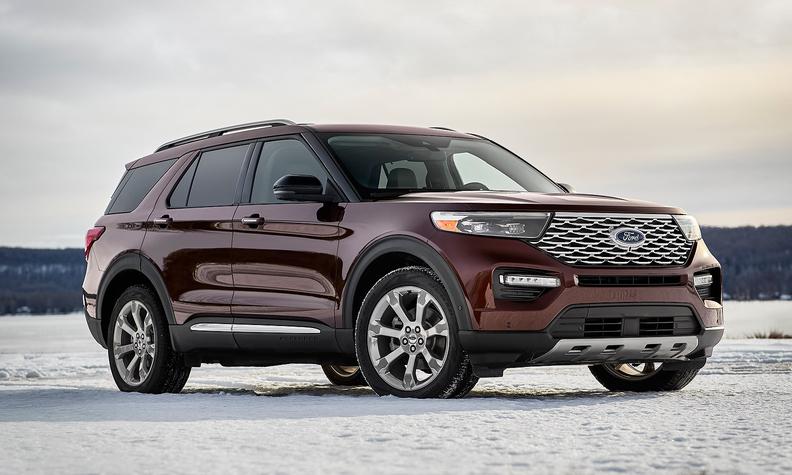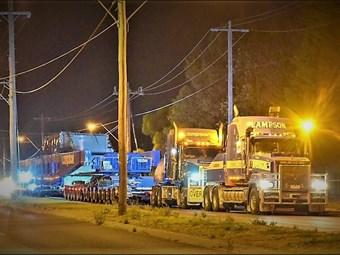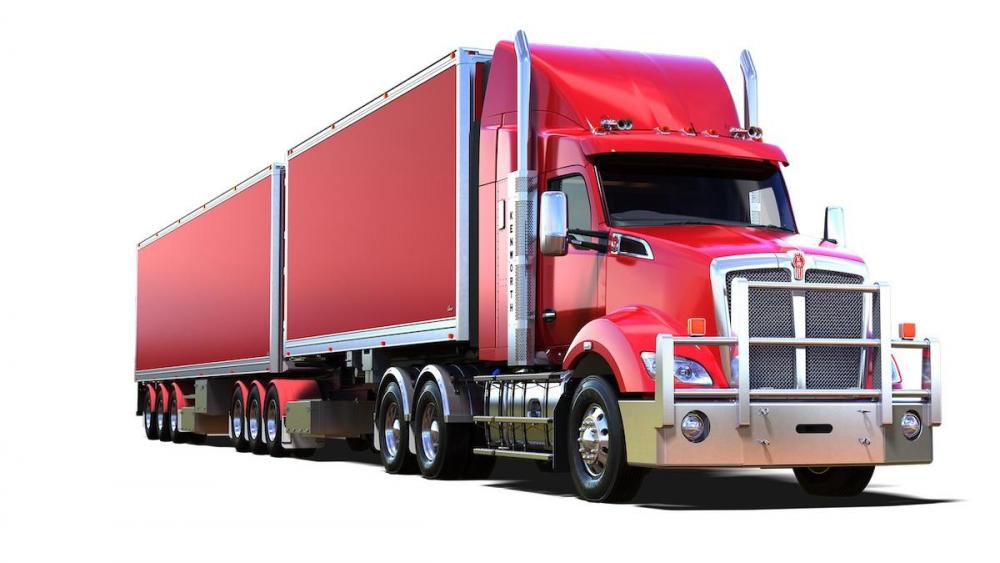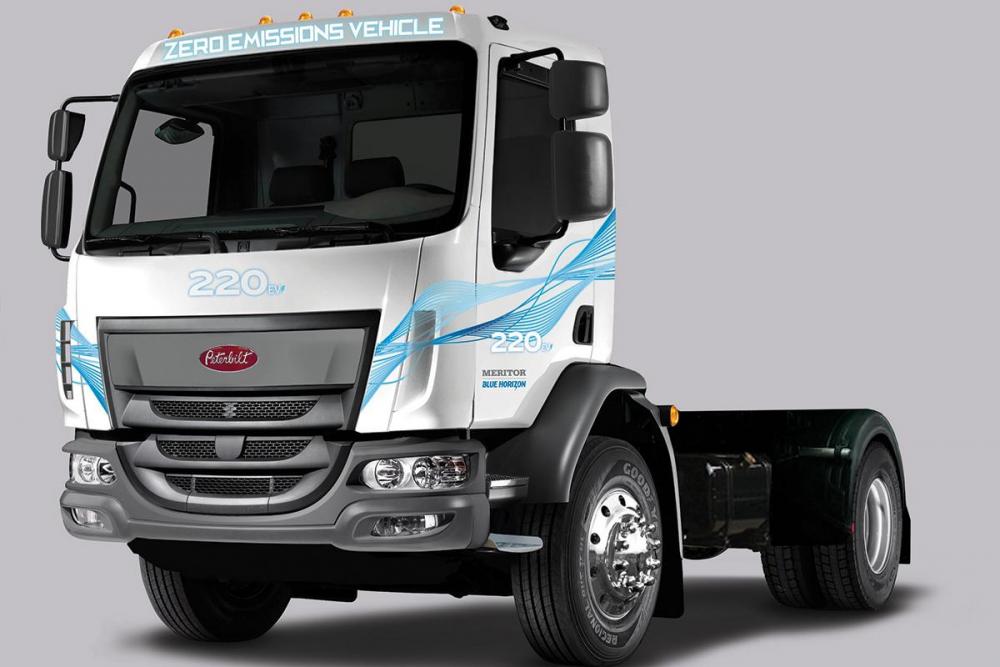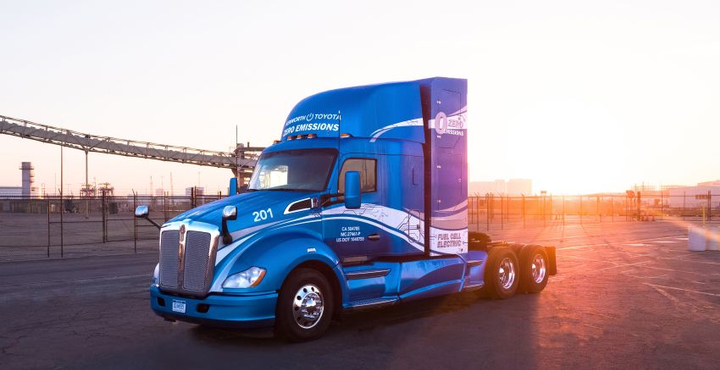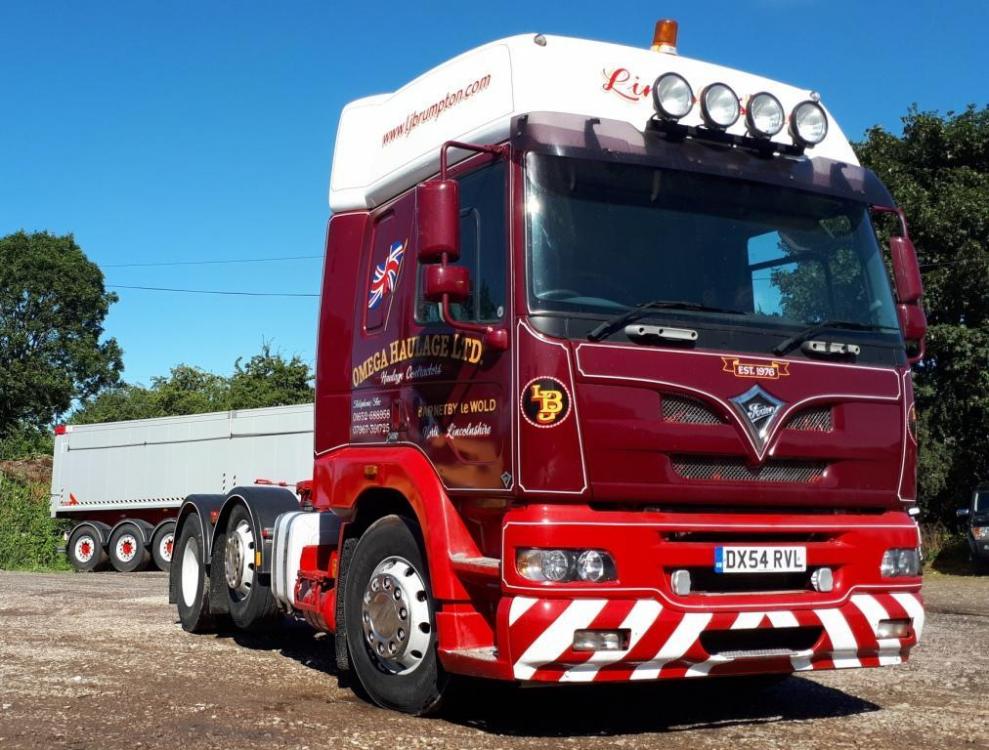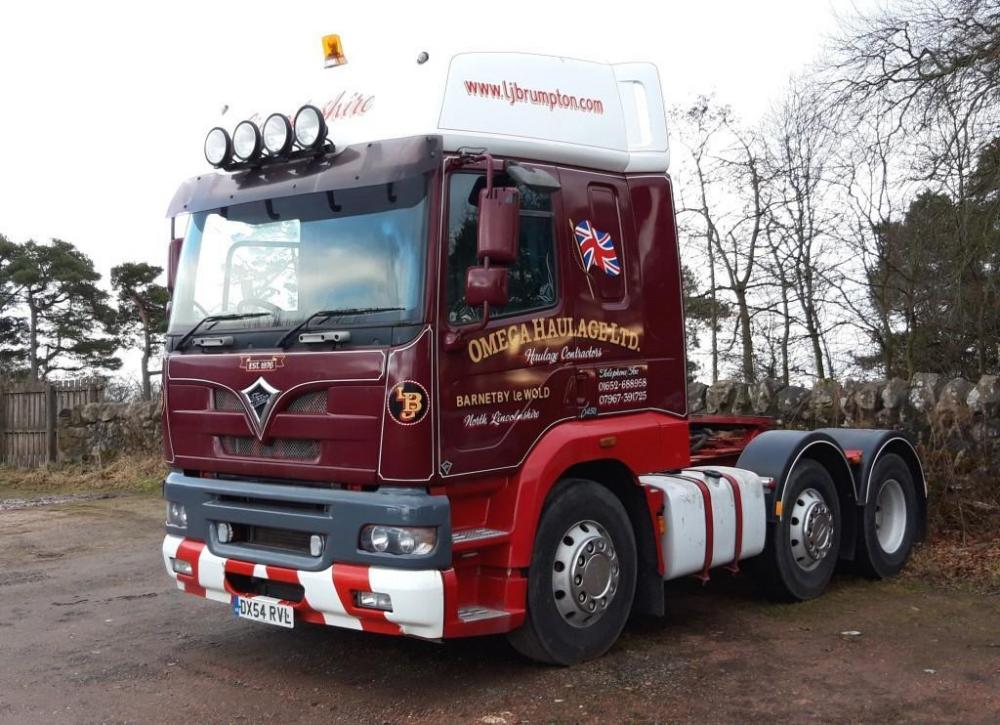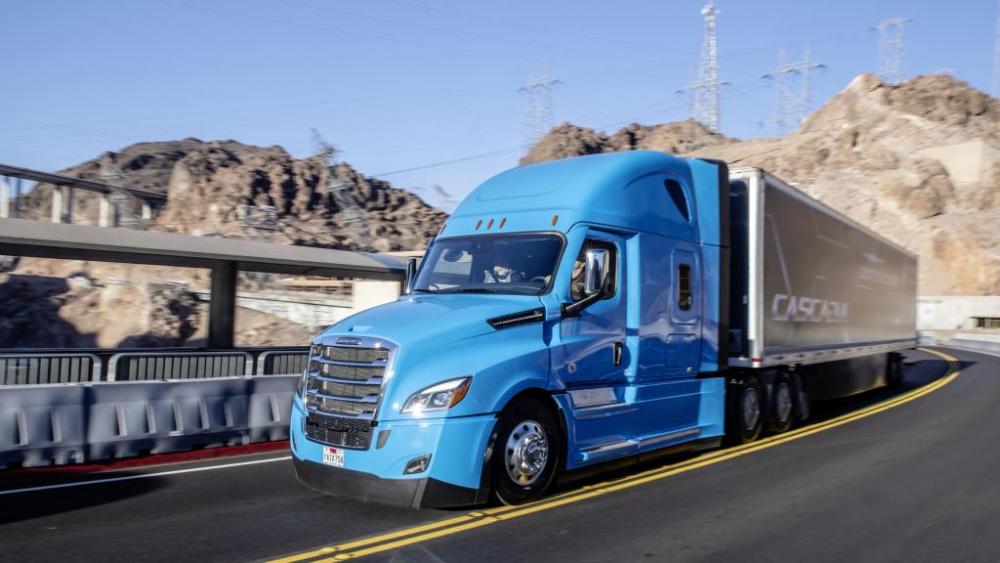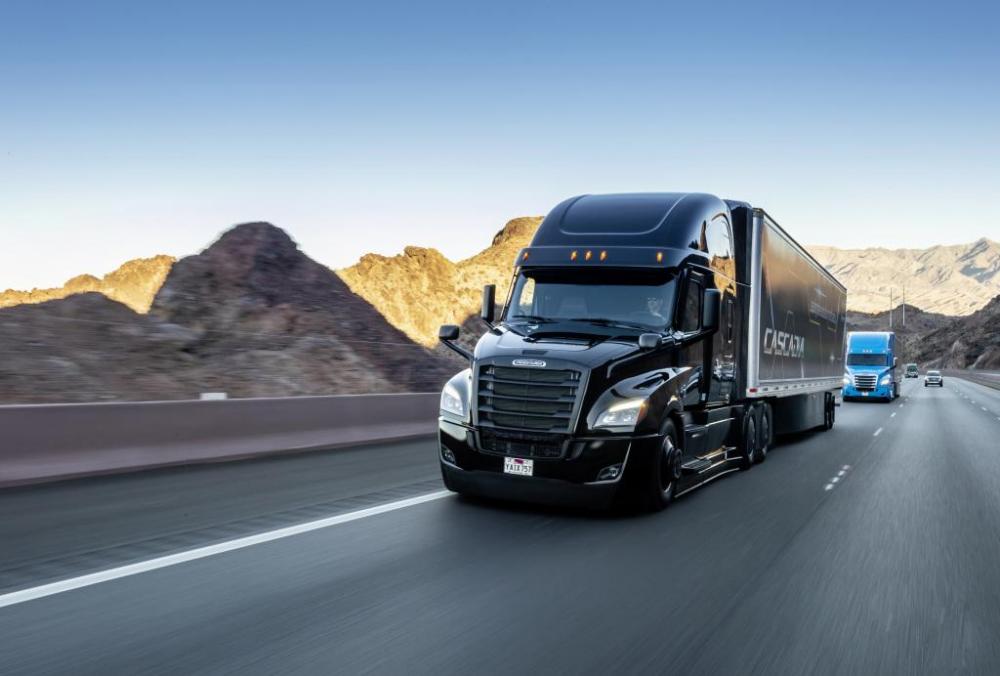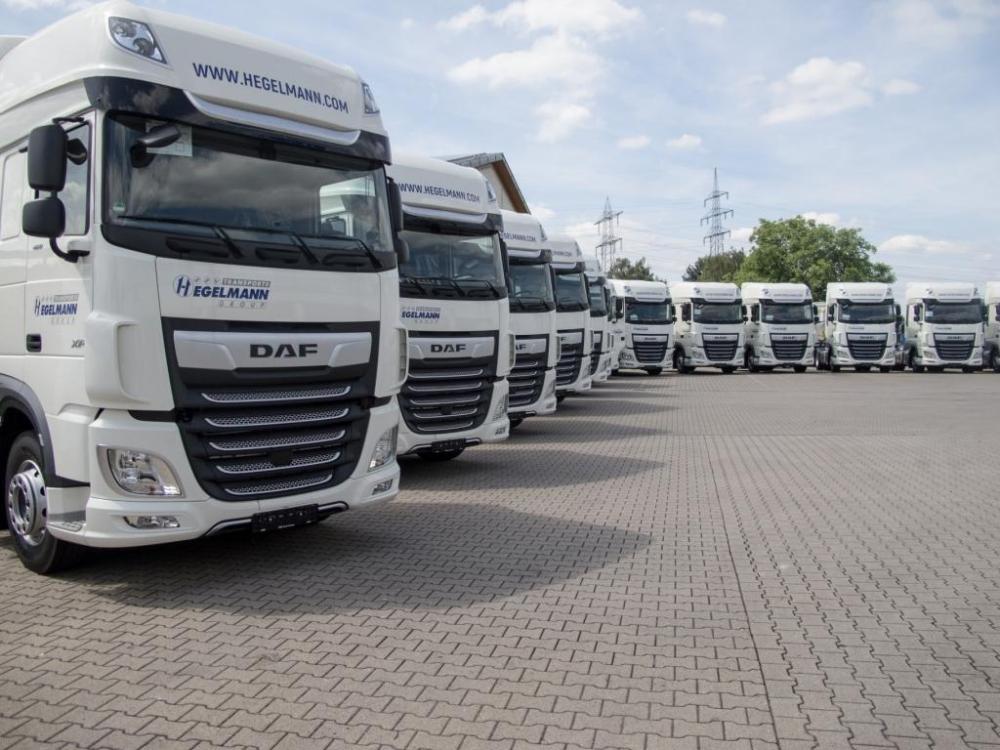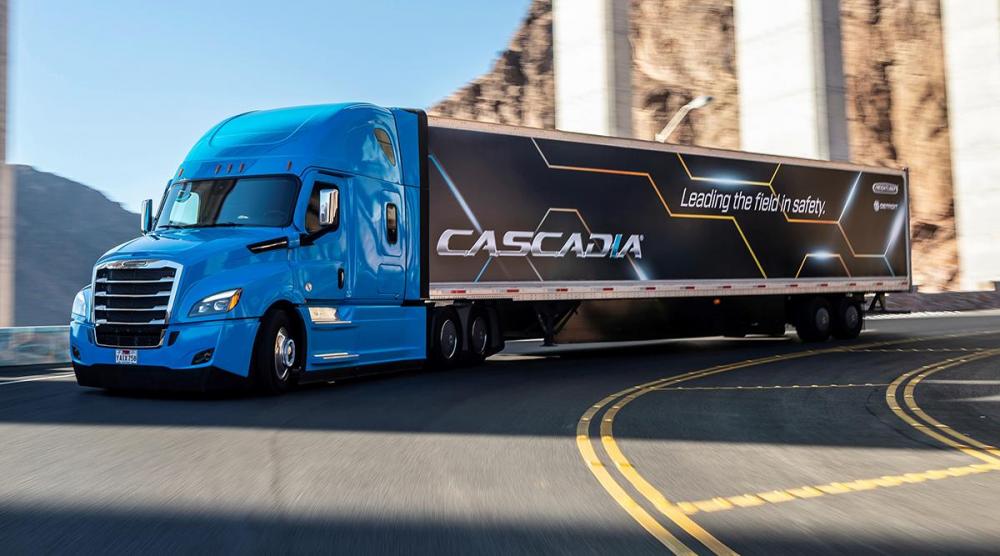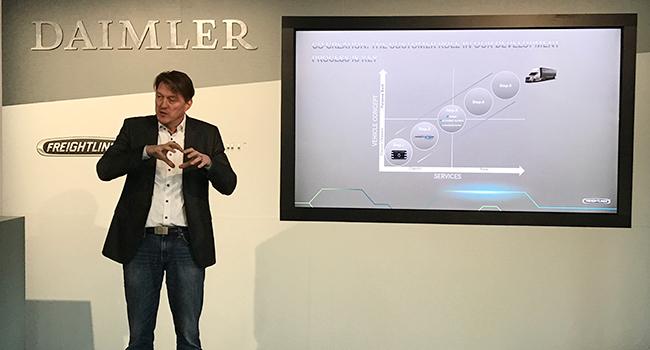
kscarbel2
Moderator-
Posts
18,908 -
Joined
-
Days Won
114
Content Type
Profiles
Forums
Gallery
Events
Blogs
BMT Wiki
Collections
Store
Everything posted by kscarbel2
-
With VW, the Piech and Porsche families (whose histories are deeply tied to Hitler and the Nazi regime).
-
Volvo Group shows Mack Granite-based M917A3 Dump Truck at AUSA 2018
kscarbel2 replied to kscarbel2's topic in Trucking News
No Jim. This has a pre-emissions Euro-3 engine like they still offer for export. Listen from 3:20 https://www.youtube.com/watch?time_continue=206&v=ZxvN5tLw4Sw -
Meritor Announces Major Electric Truck Push for 2019
kscarbel2 replied to kscarbel2's topic in Trucking News
-
Produced by Wagner for Mack, they have significantly more force, a requirement for a 20k axle versus a 12k axle. That Volvo wants to charge you $744.85 for a $200 component should be a crime. Volvo doesn't want you operating a 1996 vintage truck. And they want to rinse their hands of "American" Macks.
-
Volvo Group shows Mack Granite-based M917A3 Dump Truck at AUSA 2018
kscarbel2 replied to kscarbel2's topic in Trucking News
Mack Defense details new US Army M917A3 Heavy Dump Truck Shaun Connors, Janes International Defense Review / October 16, 2018 Mack Defense has confirmed additional M917A3 Heavy Dump Truck (HDT) technical details to Jane’s after showing the type publicly for the first time at the Association of the United States Army’s annual conference in October. Following a solicitation released on 26 May 2017 and a subsequent competition between Mack Defense and Navistar Defense, on 29 May 2018 the US Army announced that it had awarded the HDT contract to Mack Defense. The initial market survey for this requirement had been released by the US Army in 2014. The M917 is a member of the M900 series of trucks. The M900 series are based on commercial vehicles with the minimum of modifications to make them suitable for military use, and as such are not classed tactical trucks by the US Army. (MilCOTS - Militarized Commercial-Off-The-Shelf) In addition to the M917, the M900 series includes the M915 6×4 and M916 6×6 tractor trucks, and has previously included M918 6×6 bituminous distributor, M919 8x6 concrete mixer, and M920 8×6 tractor truck. Mack’s winning M917 HDT bid is based on the company’s Granite axle-forward construction grade chassis. A key differentiator between the commercial offering and the HDT is the latter requiring a force protection capability. To meet this requirement Mack offered a swap-cab solution. The drop-in armoured cab, designed by Tencate, will be manufactured by JWF Defense Systems and fitted with Jankel BLASTech seating. The gap between the dump body and cab is primarily to retain a weight balance and axle loads with the armoured cab fitted. The 18 yd³ (13.76 m³) heated steel dump body is manufactured by Crysteel Manufacturing Inc. -
Mack Brand Press Release / November 8, 2018 [Volvo Group subsidiary] Mack Defense recently showcased the Mack® Granite-based M917A3 Heavy Dump Truck (HDT) at the Association of United States Army (AUSA) 2018 show at the Walter E. Washington Convention Center in Washington, D.C. Mack Defense was awarded a $296 million contract in May 2018 to produce 683 HDTs for the U.S. Army. “The M917A3 is a great example of the capabilities Mack Defense has to develop solutions for military customers,” said David Hartzell, president of Mack Defense. “Using the rugged Mack Granite as a foundation, we were able to engineer the M917A3 to meet the U.S. Army’s challenging applications.” Based on the civilian Mack Granite model, Mack Defense optimized the M917A3 HDT to meet the current needs of the U.S. Army, while allowing for evolving requirements and future growth. Mack Defense engineers added heavier-duty rear axles and all-wheel drive, while increasing the suspension’s ride height to create a heavy dump truck capable of meeting the demanding payload and mobility requirements set by the U.S. Army HDT program. The M917A3’s cab armor was engineered by external partner experts to maintain all the comfort and driver-focused amenities of the commercial Granite model, while adding force protection to keep occupants safe in hostile environments. Mack Defense is a member of AUSA, whose vision is to be the premier voice for America’s soldiers. AUSA is committed to building the best professional and representative association for the U.S. Army. More than 30,000 attendees visited AUSA and the 700 exhibitors representing 100 countries around the world.
-
Ford Europe to cut thousands of jobs in turnaround plan Bloomberg/Reuters / January 10, 2019 Ford will shed thousands of jobs at its European operations in a bid to return the business to profitability in a broad restructuring that may include shutting down production plants. Ford has struggled with an aging model lineup and a contracting market in the UK, Ford’s biggest in Europe, which is in store for further disruption from Brexit. In a statement on Thursday, Ford said it will seek to exit the multivan segment, review its operations in Russia, and combine the headquarters of Ford UK and Ford Credit to a site in Dunton, Essex. Ford, in its statement, said it also plans to leverage relationships, "including a potential alliance with Volkswagen AG, to support commercial vehicle growth." Ford and VW could announce details of an alliance on Tuesday at the Detroit auto show. "We are looking to make a step-change in the performance of the business," said Steven Armstrong, Ford’s head of Europe. “There will be significant impact across the region. We will be looking at all options,” which could include plant closures, he told Bloomberg Ford announced in December that it was working on a restructuring plan for Europe called Sprint to 6 Reset and Redesign. The name refers to Ford’s 6 percent profit margin target for Europe. The company did not give a timeframe for the target. Ford has said the plan will involve concentrating on its profit-making SUVs and commercial vehicles and cutting unprofitable model lines, thought to refer the Galaxy and S-Max minivans. Ford has already said it will cease production at a plant in Bordeaux, France, and has started labor talks at the Saarlouis factory in Germany after a decision to end production of the C-Max compact van. The automaker, which currently employs 53,000 people in Europe, has struggled to turn a profit, posting a 245 million euros loss before interest and taxes in the third quarter, widening from $192 million a year earlier, and equivalent to a negative 3.3 percent EBIT margin. Armstrong declined to quantify the scale of job cuts, pending negotiations with labor leaders, but said staff reductions would run into the "thousands." Voluntary separations "Ford aims to achieve the labor cost reductions as far as possible through voluntary employee separations in Europe," the automaker said. Ford’s European business currently relies on models such as the recently revamped Fiesta and Focus hatchbacks. Ford, whose business in Europe includes a “solidly profitable” commercial vehicles unit, said it will establish three separate groups for passenger cars, its vans business and imports like the iconic Mustang. “We are continuing to invest in the business, especially in electrified cars,” said Armstrong. “We will still have a comprehensive lineup of cars in future with primarily SUVs and crossovers.” Over the long term, Ford is targeting earnings before interest and taxes of 6 percent of sales in Europe. This year, performance will already be “significantly better” than 2018, Armstrong said. Ford last year kicked off a company-wide $11 billion restructuring after both Europe and Asia swung to losses and costs to invest in electric and self-driving vehicles mount. Like many other carmakers, Ford has warned it won’t meet its forecasts for 2018, and CEO Jim Hackett jettisoned a goal to reach an 8 percent profit margin by 2020. .
-
Heavy Duty Trucking (HDT) / January 9, 2019 Building on the array of products and prototypes it displayed at the IAA Commercial Vehicle Show in Hannover, Germany last fall, Meritor has announced it has 22 electrification programs with global OEMs that is expected to put at least 130 fully electric medium- and heavy-duty commercial trucks on the road through 2020. "These emission-free solutions offered under Meritor's Blue Horizon technology brand have the potential to transform the industry by meeting the rising global demand for clean, electric-powered drivetrains that we believe will deliver a high-efficiency solution that greatly reduces the total cost of ownership for our customers," said John Bennett, vice president and chief technology officer for Meritor. "These programs position Meritor for future growth in an emerging industry segment." According to Meritor, in the first half of this year, a major fleet customer will begin operating the first of six medium-duty Peterbilt Model 220EV Class 6 pick-up and delivery trucks equipped with Meritor's 14Xe electric drive systems and fully integrated subsystems from TransPower, a leader in electrification technologies for large commercial vehicles. In 2017, Meritor announced a strategic investment in TransPower. Meritor's eCarrier platform integrates an electric motor into the axle, freeing up space for batteries and other components. This flexible design is the foundation for various drivetrain configurations, including full electric, hybrid and single or tandem axles with various options based on product application for vehicle Classes 5 through 8. Among the 130 commercial vehicles expected to be placed into service by 2020, 60 of these trucks received funding from the California Air Resources Board as part of a broader effort to reduce carbon emissions in freight facilities. In addition to the truck applications, a prototype school bus outfitted with Meritor and TransPower electrification solutions has been exceeding expectations during testing in Escondido, California since late May. Testing includes climbing steep grades, stop-and-go at low speeds, off-road and freeway driving as well as heavy-load hauling on rural roads. "Several large customers have come out to see and ride the bus, and their comments are very complimentary from ride comfort, noise, vibration and harshness, acceleration, top speed and design simplicity standpoints," Bennett added. .
-
Ford Explorer gains space for passengers, plywood in major RWD redesign Michael Martinez, Automotive News / January 9, 2019 DETROIT -- Ford Motor Co. is seeking to broaden the appeal of the venerable Explorer by better listening to the customers who have made it the nation's best-selling utility vehicle all time. The automaker says Explorer buyers asked for more interior space, towing capability and performance. The sixth-generation Explorer, introduced late Wednesday ahead of the Detroit auto show, will deliver on those customer wishes, Ford says. The 2020 vehicle, on sale this summer, was redesigned on a new rear-wheel-drive, unibody platform that gives it sportier styling and what Ford engineers describe as better handling. The seven-passenger crossover can tow up to 5,600 pounds -- 600 more than the outgoing version -- and has best-in-class second- and third-row headroom, Ford claims. "We built it around the way people use the car," Bill Gubing, the Explorer's chief program engineer, said at a briefing ahead of Wednesday's reveal. "Even the smallest features are designed from a customer perspective." The 2020 Explorer will be more expensive than the current version, but Ford contends that customers are willing to pay the higher prices for more content and capability. It starts at $33,860, including shipping, $400 more than the 2019 Explorer, but the base model includes more than a dozen new standard features, including a power liftgate, Ford Co-Pilot360 suite of driver assist technology and Wi-Fi connectivity. The base engine, a 2.3-liter EcoBoost inline-four, is expected to get 300 hp and 310 pound-feet of torque. It's paired with a 10-speed transmission. Buyers can upgrade to a 3.0-liter turbocharged V-6 on the high-end Platinum trim that's expected to get 365 hp and 380 pound-feet of torque. Intelligent four-wheel drive is available. Ford also plans to offer a hybrid Explorer and a high-performance ST version, which replaces the Sport trim. Ford has not yet released details on those variants. "It's our broadest-ever lineup," said Craig Patterson, Ford's marketing manager for the Explorer. "We're expanding what the role of the SUV is." More space for families The Explorer, first sold as a 1991 model with a starting price of less than $18,000, has been one of Ford's most successful nameplates and last year trailed only the F-series pickup and Escape crossover in the brand's U.S. sales. The automaker has sold 7.7 million Explorers in the U.S. since its launch, the most of any utility. Now, Ford is looking to cash in on the rapidly growing millennial demographic: 20- and 30-somethings who are getting married, having kids and looking for larger vehicles. The interior of the 2020 model is quieter and includes more head and hip room. Second- and third-row seats fold flat and can accommodate a 4- by 8-foot sheet of plywood, which wouldn't fit in the outgoing version. Ford says the 2020 Explorer gains 6.1 cubic feet of cargo space behind the front seats, a reversible floor that's easy to clean after hauling kids' mud-caked cleats and a feature that engineers have dubbed the "apple catcher" -- a lip on the rear floor that's meant to stop wine bottles or spaghetti sauce jars from rolling out of the back when the liftgate opens. Every seating position in the second and third rows has child-seat anchors, and retractable second-row sunshades are optional. Tall screen, new tech An 8-inch touch screen is standard, and there is an optional 10.1-inch screen in a portrait configuration -- taller than it is wide -- which is a first for Ford. In addition to its standard driver-assist technology, including a lane-keeping system and automatic emergency braking, the 2020 Explorer is the first North American nameplate to offer the automaker's second generation of Ford's active park assist. The feature, standard on the Platinum trim, allows drivers to parallel or perpendicular park by pressing and holding a button. Previously, the driver had to hold the steering wheel and control the braking and acceleration. "We obsessed about what Explorer customers need and want," Gubing said. "We met with customer groups, pored through Internet forums and dissected social media posts to determine what they love about today's Explorer and understand their pain points. Then we found ways to improve it across the board." U.S. sales of the Explorer fell 3.5 percent to 261,571 last year, partly because of the impending redesign. But the vehicle still outsold its primary rivals, the Toyota Highlander and Chevrolet Traverse, in a segment that grew 11 percent. The Explorer was last overhauled for the 2011 model year, when it shed its truck-based mechanicals and adopted Ford's front-wheel-drive, unibody platform that underlies the Ford Taurus sedan and Flex crossover. Photo gallery - https://www.autonews.com/gallery/detroit-photo-gallery/2020-ford-explorer .
-
FCA to pay about $800 million to settle diesel emissions suits David Shepardson, Reuters / September 9, 2019 WASHINGTON -- Fiat Chrysler Automobiles NV has agreed to a settlement worth about $800 million to resolve claims from the U.S. Justice Department and state of California that it used illegal software that produced false results on diesel-emissions tests, but still faces an ongoing criminal probe. The hefty penalty is the latest fallout from the U.S. government's stepped-up enforcement of vehicle emissions rules after Volkswagen AG admitted in September 2015 to intentionally evading emissions rules. The Fiat Chrysler settlement includes $311 million in total civil penalties to U.S. and California regulators, up to $280 million to resolve claims from diesel owners, and extended warranties worth $105 million. It covers 104,000 Fiat Chrysler 2014-16 Ram 1500 and Jeep Grand Cherokee diesels, the Justice Department said. Regulators said Fiat Chrysler used "defeat devices" to cheat emissions tests in real-world driving. For more details about the settlements from the EPA, click here. FCA, in a statement, emphasized the settlements "do not change the company’s position that it did not engage in any deliberate scheme to install defeat devices to cheat emissions tests. Further, the consent decree and settlement agreements contain no finding or admission with regard to any alleged violations of vehicle emissions rules." The company already set aside about $800 million for the settlement. Customers will each receive about $2,800 in compensation from the settlement, FCA said. “We acknowledge that this has created uncertainty for our customers, and we believe this resolution will maintain their trust in us,” Mark Chernoby, FCA's head of North American safety and regulatory compliance, said in the statement. “We have implemented rigorous new validation procedures and updated our training programs to ensure continued compliance with the increasingly complex regulatory environment,” he added. “Such measures are consistent with our mission to deliver advanced technologies that deliver value to our customers and that enhance the environmental performance of our products.” 'Serious problem' "You wouldn't pay $311 million total dollars to the federal government in civil penalties if there were not a serious problem," U.S. assistant attorney general Jeff Clark told a news conference. The settlement also includes $72.5 million for state civil penalties, and $33.5 million in payments to California to offset excess emissions and consumer claims. German auto supplier Robert Bosch GmbH, which provided the emissions control software for the vehicles, also agreed to pay $27.5 million to resolve claims from diesel owners. Owners will receive an average of $2,800 to obtain software updates as part of the emissions recall, Fiat Chrysler said. Elizabeth Cabraser, a lawyer for the owners, said the "substantial cash compensation" will ensure that consumers get the recall fix. Bosch, which also provided diesel emissions software to Volkswagen, also agreed to pay $103.5 million to settle claims with 47 U.S. states that said the supplier "enabled" the cheating and should have known its customers would use the software improperly, the New York Attorney General's Office said. Bosch said in a statement it did not accept liability or admit to the factual allegations, but that the settlement reflects "Bosch’s desire to move forward and to spare the company the very substantial costs and the burden on the company’s resources that would be required to litigate these issues." The Justice Department said the settlement does not resolve an ongoing criminal investigation into Fiat Chrysler's conduct, but officials declined to discuss the status. The U.S. Securities and Exchange Commission is also investigating. 'Don't cheat' U.S. regulators are also investigating Daimler AG for alleged excess emissions in Mercedes-Benz diesel vehicles, but the Justice Department and Environmental Protection Agency declined to comment on the status of the probe -- and would not say if any other automakers are under scrutiny. Daimler declined to comment Thursday but has acknowledged it faces investigations in Germany and the United States. In October, Daimler said operating profit would fall by more than 10 percent, blaming "government proceedings and measures in various regions" in referencing diesel emissions issues. U.S. regulators said the industry was getting a tough message. "Fiat Chrysler deceived consumers and the federal government by installing defeat devices on these vehicles that undermined important clean air protections," said Andrew Wheeler, acting administrator of the EPA. "Today’s settlement sends a clear and strong signal to manufacturers and consumers alike -- the Trump administration will vigorously enforce the nation’s laws designed to protect the environment and public health." Wheeler said the settlement message is simple to automakers: "Don't cheat." The case dragged on after the Justice Department filed suit in May 2017 and the sides remained far part. At one point, the Justice Department sought $1.4 billion in civil penalties from Fiat Chrysler -- or about a $1 billion more than the company ultimately paid, two people briefed on the matter said. The Justice Department said Fiat Chrysler must work with one or more vendors of aftermarket catalytic converters to improve the efficiency of 200,000 converters that will be sold in the 47 U.S. states that do not already require the use of the California-mandated high-efficiency gasoline vehicle catalysts. That is estimated at $50 million to $70 million, officials said. California Attorney General Xavier Becerra said in a statement, "Fiat Chrysler tried to evade these standards by installing software to cheat emissions testing. The company not only violated the law and our trust, but did so at the expense of our environment." U.S. Principal Deputy Associate Attorney General Jesse Panuccio said at a news conference that automakers were on notice: "If you cheat our emissions tests you are going to get caught." Fiat Chrysler has agreed to an enhanced whistleblower program and the company must implement corporate governance, organization and technical process reforms to minimize the likelihood of future Clean Air Act violations and must hire a compliance auditor to oversee and assess the reforms. With the Fiat Chrysler settlement, the U.S. Justice Department's total civil fines for both Fiat Chrysler and Volkswagen are now valued at around $2,500 per vehicle. In total, Volkswagen agreed to pay more than $25 billion in the United States for claims from owners, environmental regulators, states and dealers, including spending as much as $15 billion to buy back about 500,000 polluting U.S. vehicles. The company pleaded guilty to three felony counts to resolve the criminal probe. The settlement will be open for public comment for 30 days before a federal judge decides whether to approve the agreements.
-
Rare 'Smokey and the Bandit' Kenworth W925 hits Alexandra show
kscarbel2 replied to kscarbel2's topic in Trucking News
https://www.bigrigs.com.au/news/want-own-your-own-smokey-and-bandit-replica-truck/3617910/ -
Australasian Transport News (ATN) / January 9, 2019 A 663-tonne ‘superload’ is powering through western Victoria on a three-night journey. The wind farm transformer cargo, hauled by Lampson Australia, started at the Port of Geelong on Januery 7 and will end up at Haunted Gully at Lismore on January 10 – traversing about 220 kilometres and moving no faster than 20km/h throughout its expedition. At 115 metres long, the convoy is longer than an Airbus A380 (73 metres). It’s also 5.12 metres wide, taking up two lanes, and is 5.5 metres tall, making it the biggest superload to ever come to south western Victoria, VicRoads says. It is being moved by four prime movers – with three trucks at the front pulling, and one at the rear pushing the load. It slightly edges the 558-tonne, 108-metre ‘megaload’ which thundered through Melbourne and Victoria’s east last year. "This is a complex and dynamic operation that has been months in the planning – we’ll be monitoring this convoy every step of the way to ensure the smoothest possible journey and the safest possible road network," VicRoads acting director of heavy vehicle services Marc Paglia says. "We’ll be escorting this convoy to help ensure a straight forward journey, but it’s important to note drivers may experience delays if they encounter this huge, rolling transport." Traffic lights and signage is being moved and replaced by support crews and steel supports placed over existing drains to ensure the convoy has the safest possible journey and doesn’t damage important infrastructure on the way through. .
-
Truck News Australia / January 2019 Kenworth has added flexibility to its range with the T610 Aero Sleeper launched onto the market for 2019. The 600mm aero roof sleeper cab complements the existing day-cab, 760mm mid-roof and 860mm sleeper cab options. The most compact sleeper in the T610 range, the 600mm offers improved fuel efficiency and payload capacity up to 26m B-double configurations The new sleeper cab option is suitable for a variety of applications, including tippers, tankers and refrigerated trailers. “As a conventional model, the T610 with 600mm sleeper option is unique in its ability to offer both a sleeper and a bullbar in combination with full-length 34 pallet trailer sets and still fit within the 26m B-double envelope,” said Brad May, Paccar Australia’s Director Sales and Marketing. “The new sleeper option provides maximum productivity, optimal fuel efficiency supported by the T610’s aerodynamic lines, while reducing costs incurred by road damage. “With more head room, the new sleeper provides comfortable resting facilities to aid in managing driver fatigue, and offers a great option for those doing shuttle work. It really is an efficient, safe and productive alternative”. Designed specifically for the Australian road transport market and centred around the needs of the driver, the T610 has delivered improved space, visibility and ergonomics. The design of the cabin makes it easier for the driver to move around in and rest during breaks. The new 600mm aero roof sleeper offers left and right hand sleeper vents, open shelving, foam mattress with hinged pan for under bunk storage, a windscreen privacy curtain and sleeper blackout curtain. An optional under-bunk storage drawer and 42L fridge are also available. The result of more than 100,000 Australian design hours and more than ten million kilometres of testing and validation, the T610 program was the single largest investment in product development Kenworth has ever made in Australia. From idea to reality, this significant investment in new technologies and design is specifically for the Australian road transport market. .
-
Aaron Marsh, Fleet Owner / January 8, 2019 Not to be outdone by their more numerous light-duty siblings, medium-duty trucks covering Classes 4-6 have been the object of a flurry of development and experimentation the last few years. They're often on the job with upfit bodies of various kinds serving trades and utilities or handling last-mile and metro/urban-area deliveries and distribution, and they have the benefit of not requiring a commercial driver's license to operate. That adds to their appeal, since fleets can hire drivers from a much larger potential employee pool. Not only do these trucks have impressive capabilities, their typically shorter-range duty cycles have also made medium-duty trucks good candidates for electric power. While many electric trucks in these and even the heaviest classes are being developed, tested, and prototyped, medium duty is where you'll now find commercially-ready fully electric trucks for fleet purchase. A standout example is the Class 4 Mitsubishi Fuso eCanter in the Daimler Trucks stable, which will see full production launch this year. Meanwhile, Fuso also recently expanded engine options in its FE Series cabovers with General Motors' 6.0L gasoline V8. These middle classes of trucks—often called “work trucks” since they serve many commercial purposes beyond hauling freight—offer the broadest range of power options. It's not only commercial/fleet ready electrics but also more alternative fuel choices. That includes the least common of those options: look to Freightliner Custom Chassis Corp.'s S2G for a factory-installed propane engine (GM's 8.0L V8 prepped for liquefied propane gas). Cab-type options abound in medium duty as well. Joining Ram Trucks' 4500-5500 Chassis Cabs and Ford's Super Duty F-450/ F-550/ F-650 conventional-cab trucks that offer regular and crew variants to suit passenger needs are all-new offerings from a collaboration between Navistar and Chevrolet. Navistar's Springfield, OH, plant will produce the International CV Series Class 4-5 and Chevrolet Silverado 4500HD, 5500HD, and 6500HD chassis cabs unveiled over the course of 2018. They'll have different dealer networks, but all are designed to easily accept a variety of upfit bodies and offer regular/ crew cab passenger capacity options. Supplementing the CV Series with even larger conventional cab trucks is International's MV Series, notably also launched in 2018 and built at the same plant. It's available as day cab, extended cab, and crew cab models with wheelbases from 128 to 254 in. While it looks the part of the larger truck, the MV is designed for greater maneuverability and ease of operation. For fleets that require greater passenger capacity but prefer to get it done with a tight-turning cabover, there are plenty to choose from. Isuzu offers regular and crew cab variants of its popular NPR, NQR, and NRR cabover trucks, which the OEM also builds for bowtie badges in Chevrolet's Low-Cab Forward 3500, 4500, and 5500 cabovers. Isuzu's biggest Class 6 FTR and the Chevy 6500XD come only in regular/single cab models for now but allow extensive wheelbase configurations—they can sport box bodies up to 30-ft. long. Fuso's FE cabovers include big-cab options, too, as do Hino's 155 and 195 trucks, and those two manufacturers also have two of the most unique models in the medium-duty classes. Fuso's FG4X4 has a switchable rear-wheel-drive/all-wheel-drive system, the only cabover available with that drivetrain. And how about a cabover with space for up to seven passengers and partially electric motivation? That's available with Hino's Class 5 195h-DC, which signifies it's a hybrid double cab. It's got an almost oddball combination of an elongated cabover design and 5L turbo diesel engine with piggybacked electric power. Hino's Hybrid Adaptive Control System communicates continuously with the engine's electronic control unit to evaluate driving conditions and adjust the support it lends to the diesel, improving fuel efficiency and lowering emissions.
-
Peterbilt Unveils Electric Medium-Duty Truck at CES
kscarbel2 replied to kscarbel2's topic in Trucking News
-
Seth Clevenger, Transport Topics / January 8, 2019 LAS VEGAS — Peterbilt Motors Co. has unveiled an all-electric medium-duty truck, adding a third model to its emerging electric-vehicle lineup. The truck maker introduced the zero-emissions Model 220EV on Jan. 8 here at CES, the world’s largest technology trade show. The battery-electric cabover, geared toward local pickup and delivery operations, has a 100-mile range and can recharge in an hour when plugged into a fast-charging system, the manufacturer said. Peterbilt said it plans to begin delivering the Model 220EV in the summer and will place six of the trucks into service this year with an undisclosed customer. The Model 220EV is equipped with two TransPower battery packs for a total storage capacity of 148 kilowatt hours and a Blue Horizon two-speed drive eAxle from Meritor Inc. The medium-duty model joins two other electric trucks introduced by Peterbilt within the past two years: the Model 579EV, a Class 8 tractor for port drayage and regional applications, and the Model 520EV, an electric refuse truck. Altogether, Peterbilt said it will have more than 30 electric vehicles on the road by the end of this year with customers in regional haul, refuse and urban delivery applications. “Peterbilt has been at the forefront of truck electrification, and adding the medium-duty platform to our electric truck lineup was a natural evolution of our development plan,” Peterbilt General Manager Jason Skoog said in a statement. “We will now have trucks in the three applications where electric powertrains may have a return on investment for our customers.” Peterbilt currently has Model 579EVs and 520EVs on the road in customer field trials. The truck maker also is conducting validation testing at the Paccar Technical Center in Mount Vernon, Wash. Peterbilt said it will use the data collected through its customer trials and testing to help ensure that its electric vehicles meet the same standards as its diesel trucks. .
-
Toyota Explores Heavy Truck Hydrogen Fuel Cell Application
kscarbel2 replied to kscarbel2's topic in Trucking News
Toyota, Kenworth Collaborate on Zero-Emission Trucks Heavy Duty Trucking (HDT) / January 8, 2019 Kenworth Truck Company and Toyota Motor North America are collaborating to develop 10 zero-emission Kenworth T680s powered by Toyota hydrogen fuel cell electric powertrains. This collaboration is part of a $41 million Zero and Near-Zero Emissions Freight Facilities (ZANZEFF) grant preliminarily awarded by the California Air Resources Board (CARB), with the Port of Los Angeles as the prime applicant. The grant monies are part of a larger $82 million program that will put fuel cell electric tractors, hydrogen fueling infrastructure, and zero emissions cargo handling equipment into operation in the ports and Los Angeles basin in 2020. The Kenworth T680s will transport cargo across the Los Angeles basin and to inland cities – such as Ontario and San Bernardino – while generating zero emissions, other than water vapor, thanks to their fully electric hydrogen fuel cell powertrain integrations co-developed by Kenworth and Toyota. The Kenworth T680s with the Toyota hydrogen fuel cell electric powertrains combine hydrogen gas and air to produce electricity. The electricity powers electric motors to move the trucks, while also charging the lithium-ion batteries to optimize performance as needed. Sophisticated power management systems will apportion the electrical power from the fuel cells to the motors, batteries, and other components, such as electrified power steering and brake air compressors. The hydrogen fuel cell electric powered Kenworth T680s will have a range of over 300 miles under normal drayage operating conditions. The program will also fund foundational hydrogen fuel infrastructure, including two new fueling stations that, subject to a final investment decision by Equilon Enterprises LLC (dba Shell Oil Products U.S.), will be developed through Shell Oil Products U.S., to support the operation of the fuel cell electric trucks in Southern California. . -
Truck & Driver / January 3, 2019 https://www.truckanddriver.co.uk/big-lorry-blog/happy-new-year-from-truck-driver-and-biglorryblog-introducing-our-foden-alpha/ .
-
- 1
-

-
Daimler Trucks North America Introduces First SAE Level 2 Automated Truck in North America with the Freightliner New Cascadia Daimler Press Release / January 7, 2019 LAS VEGAS, Nev. – Jan. 07, 2019 – Today, Daimler Trucks North America (DTNA) introduced the first SAE Level 2 automated truck in series production in North America with the latest enhancements to the Freightliner new Cascadia®. Level 2 automation means the truck is capable of both lateral (steering) and longitudinal (acceleration/deceleration) control, and is part of the revolutionary truck technologies featured by DTNA at the Las Vegas Motor Speedway during the 2019 Consumer Electronics Show (CES). According to NHTSA, ninety-four percent of crashes are attributable to human error. Automating acceleration, deceleration, and steering reduces the chance for human error, mitigates collisions, and can potentially save lives. These technologies can also enhance the driver experience by making the truck-driving task easier, thereby improving driver comfort and well-being. DTNA’s expertise in automation is backed by Daimler Trucks, which announced today at CES an investment of over half a billion dollars and an addition of more than 200 new jobs in its global push to put highly automated trucks (SAE Level 4) on the road within a decade. Most of these jobs will be located at the new Daimler Trucks Automated Truck Research & Development Center at DTNA’s headquarters in Portland, Ore. Automation for Safety, Driver Experience, and Efficiency In May 2015, DTNA pioneered automated driving with the introduction of the Freightliner Inspiration Truck, which was the first automated truck licensed to operate on U.S. public highways. Today, the new Cascadia delivers SAE Level 2 driving capabilities with the Detroit Assurance® 5.0 suite of camera- and radar-based safety systems. This new, proprietary system marks a key milestone in Freightliner’s relentless pursuit of industry-leading overall safety, driver experience, and fuel efficiency. The system can accelerate, decelerate, and steer independently. The Detroit Assurance 5.0 Adaptive Cruise Control and Active Lane Assist features make automated driving possible in all speed ranges for the first time in a series production truck: Adaptive Cruise Control to 0 mph: Improves safety, efficiency, and driver comfort by automatically decelerating and accelerating to maintain a safe following distance. This technology is especially important for maintaining a comfortable driving experience in congested traffic conditions where repeated braking, accelerating and resetting of traditional cruise control can lead to driver fatigue. Active Lane Assist: Consists of Lane Keep Assist and Lane Departure Protection. When Adaptive Cruise Control is enabled, Lane Keep Assist supports the driver by using micro-steering movements to keep the new Cascadia centered in its detected lane. With Lane Departure Protection, if the truck begins to drift without the turn signal engaged, the system will counter steer the truck back into its lane and give an auditory and visual warning. In addition to Level 2 automated driving features, the Detroit Assurance 5.0 active safety and advanced driver assistance systems are designed to keep truck drivers, pedestrians, cyclists, and other motorists safe: Active Brake Assist 5.0: The fusion of Detroit Assurance 5.0 camera and radar technology detects moving pedestrians and cyclists in front of the truck and can deploy full braking – an industry first. It can also detect and mitigate a collision with full braking on moving and stationary vehicles and objects. Side Guard Assist: Detects objects, including pedestrians and cyclists, in the passenger-side blind spot for the tractor and a full-length 53-foot trailer, another industry first, and delivers an audible and visual warning. “The enhancements we’ve made to Detroit Assurance have the potential to make an immediate, measurable and positive impact on overall North American road safety,” said Kelly Gedert, director of product marketing for Freightliner and Detroit. “In fact, fleets with trucks equipped with forward collision mitigation systems can experience a 60% to 80% reduction in rear-end crashes, resulting in potentially fewer accidents and reduced operational costs to our customers.” Detroit™ Connect Analytics will provide fleets with analysis and key insights on the performance of the new Detroit Assurance 5.0 safety features. Fleets will be notified if drivers have their hands off the wheel for longer than 60 seconds. Aerodynamic and Powertrain Efficiency Gains The new Cascadia also features one of the industry’s most efficient designs, inside and out. Thanks to DTNA’s significant investment in ongoing R&D in aerodynamics, powertrain development and systems intelligence, the new Cascadia delivers a 35% improvement in fuel efficiency compared to the first Cascadia introduced in 2007. This equates to annual savings of up to 4,700 gallons of fuel per truck, which is the amount of fuel consumed by six typical family cars in a year. Aerodynamic enhancements to the new Cascadia include Aerodynamic Height Control. An industry first, Aerodynamic Height Control electronically lowers the suspension height at 55 mph to optimize airflow over and under the front of the truck and reduce drag. Other enhancements include Michelin X Line D+ Energy tires developed in collaboration with Michelin, which reduce rolling resistance in 6x4 applications, and a low ground clearance bumper. Another critical component of the new Cascadia’s performance is its Integrated Detroit Powertrain, a powerful combination of a proprietary heavy-duty engine, transmission, and axle that is designed to seamlessly work together for maximum efficiency. The integrated powertrain features Intelligent Powertrain Management 6, which uses the truck’s kinetic energy to automatically adjust to the truck’s surroundings by reducing braking power and making transmission and engine adjustments, saving fuel and reducing wear and tear on components. “It’s not just the new Cascadia’s aerodynamic shape, specific options or powertrain components that make it the best – it’s that these features are engineered to seamlessly work together,” said Kary Schaefer, general manager, marketing and strategy for Daimler Trucks North America. “And we are the only truck manufacturer to offer that level of integration.” For fleets concerned with fuel economy, Detroit Connect Analytics will also introduce new Intelligent Powertrain Management reporting capabilities, and the fuel analysis will indicate if the vehicle is using Aerodynamic Height Control. “With more than 65,000 customer deliveries to date and 50,000 on order, the new Cascadia has proven to be the Class 8 truck of choice in the industry,” continued Schaefer. “We’re proud to be once again raising the bar.” .
-
Daimler Press Release / January 7, 2019 World premiere of the new Freightliner Cascadia with partially automated driving features (level 2) Start of series development of highly automated driving (level 4), enabling automated driving mode on specific routes without required user intervention Increasing safety, boosting transportation performance and significantly cutting costs per mile New R&D center for automated trucks fosters knowledge transfer for accelerated speed of innovation Martin Daum: “As a leader of our industry, we’ve been pioneering automated trucking. In 2015, our Freightliner Inspiration Truck got the first road license ever for an automated commercial vehicle. Now we take automated trucking to the next level: we’re ready to launch the first partially automated new Freightliner Cascadia in 2019 – and next, we tackle highly automated trucks. Highly automated trucks will improve safety, boost the performance of logistics and offer a great value proposition to our customers – and thus contribute considerably to a sustainable future of transportation.” Stuttgart / Las Vegas. Today at the Consumer Electronics Show (CES) in Las Vegas, Daimler Trucks announced that it will invest EUR 500 million (around 570 million USD) over the next years and create more than 200 new jobs in its global push to bring highly automated trucks (SAE level 4) to the road within a decade. Highly automated driving is characterized as automated travel in defined areas and between defined hubs without any expectation of the system that a user will respond to a request to intervene. In commercial trucking, level 4 is the natural next step after level 2, increasing efficiency and productivity for customers, cutting costs per mile significantly. In doing so, Daimler Trucks is skipping the intermediate step of conditionally automated driving (level 3). Level 3 automated driving does not offer truck customers a substantial advantage compared to the current situation as there are no corresponding benefits to compensate for the technology costs. The new Freightliner Cascadia offers partially automated driving features (level 2), making it the first-ever partially automated series production truck on North American roads. It also made its world premiere during today’s presentation of Daimler Trucks at CES. Daimler Trucks has been a pioneer of automated truck development for years. In 2014, the world’s leading truck manufacturer presented the Mercedes-Benz Future Truck 2025, the world’s first automated truck, and was the first to demonstrate the technological opportunities and great potential that automated trucks have for the economy and society. Martin Daum, Member of the Board of Management of Daimler AG with responsibility for Daimler Trucks & Buses: “As a leader of our industry, we’ve been pioneering automated trucking. In 2015, our Freightliner Inspiration Truck got the first road license ever for an automated commercial vehicle. Now we take automated trucking to the next level: we’re ready to launch the first partially automated new Freightliner Cascadia in 2019 – and next, we tackle highly automated trucks. Highly automated trucks will improve safety, boost the performance of logistics and offer a great value proposition to our customers – and thus contribute considerably to a sustainable future of transportation.” Level 2 automated driving now a reality in the new Freightliner Cascadia With Active Drive Assist (Mercedes-Benz Actros, FUSO Super Great) and Detroit Assurance 5.0 with Active Lane Assist (Freightliner new Cascadia), Daimler Trucks is already bringing partially automated driving features into series production. The new system can independently brake, accelerate and steer. Unlike systems that only work above a certain speed, Active Drive Assist / Detroit Assurance 5.0 make partially automated driving possible in all speed ranges for the driver for the first time in a series production truck. Active lateral control and the connection of longitudinal or lateral control in all speed ranges are new thanks to the fusion of radar and camera information. Daimler Trucks reassessing the benefits of platooning Moving forward with its innovation roadmap, Daimler Trucks is reassessing its view on platooning. Daimler Trucks defines platooning as the electronic coupling of two or more trucks with significantly reduced distance between them to, in theory, improve aerodynamics and therefore save fuel. Daimler Trucks has tested platooning for several years, especially in the U.S., where benefits would be expected to be the most substantial. Results show that fuel savings, even in perfect platooning conditions, are less than expected and that those savings are further diminished when the platoon gets disconnected and the trucks must accelerate to reconnect. At least for U.S. long-distance applications, analysis currently shows no business case for customers driving platoons with new, highly aerodynamic trucks. Daimler Trucks will, of course, remain committed to all partner projects that are still ongoing. Level 4 automated driving improves safety, efficiency and competitiveness Highly automated trucks (level 4) offer enormous advantages in many areas. In today’s society, there is a growing desire for safer roads and more sustainable transport solutions – and level 4 trucks can considerably contribute to that. They enhance safety in traffic thanks to a redundancy of systems and a multitude of sensors and systems that never get tired or lose attention – because today, a great majority of accidents are still due to human error. Level 4 highly automated trucks also improve efficiency and productivity, among other things, through higher utilization of the vehicles – practically around the clock. They also make it possible to travel during light traffic times, for example at night, and thus avoid traffic jams by intelligent route management. This has positive effects for truck customers and for the entire economy: the competitiveness of an economy is strongly correlated with the efficiency of logistics. This aspect becomes more and more relevant as global road freight volume is expected to more than double between 2015 and 2050. 200 new jobs for engineers or robotics specialists with IT and programming skills Daimler Trucks is creating 200 new jobs in the area of highly automated driving (level 4). The newly created positions and roles are to be filled primarily by mechatronics engineers or robotics specialists with IT and programming skills. The main location is Daimler Trucks & Buses new Automated Truck Research & Development Center in Portland (Oregon, U.S.). The center’s experts are dedicated to all aspects of developing, testing and validating automated vehicles. In addition, the engineers in Portland work in close cooperation with their colleagues in the research and development centers at Daimler Trucks locations in Stuttgart (Germany) and Bangalore (India), thus forming a global network. Interested talents can apply at https://daimler-trucksnorthamerica.com/lead/ or directly to innovateDTNA@daimler.com. Requirements for highly automated driving of cars and trucks differ considerably A crucial success factor for the development of a safe and reliable level 4 highly automated truck is a closely coordinated system of engineering and technology development. Daimler Trucks uses the extensive knowledge from many years of experience in developing driver assistance systems. And the transfer of knowledge within the Daimler Group forms the basis of a high speed of innovation. Thanks to its overall portfolio ranging from passenger cars and vans all the way to buses and trucks, the Daimler Group is ideally positioned for all relevant application scenarios of automated driving. Scalable solutions are therefore available. Across all divisions, the company is guided by a clear philosophy which is based on introducing a safe, dependable and mature system. Developments from the Mercedes-Benz Cars division suitable for haulers and their transport needs will also be used at Daimler Trucks. Level 2 systems now available will be raised to level 4 through innovation and the re-definition of existing systems. Despite all the similarities, the requirements for highly automated driving of cars and trucks differ considerably from one another. The sheer size of a truck makes higher demands on the technology than in the passenger car sector as do moving systems on an articulated system, for example. In addition, the driving behavior due to a greater mass or other deceleration values as well as other driving characteristics, for example in curves, place much higher demands on the system. The operating conditions in the transport industry are also much tougher. In order to enable efficient delivery cycles and to meet customer requirements for fast delivery, the vehicles must be operated for as long as possible. This must not lead to any restrictions in durability or reliability, for example under a wide variety of weather conditions and extreme vibrations. Finally, public acceptance is a key factor to successfully integrating level 4 systems into the value chain. Two sensors are currently in use at level 2. In the next development step at level 4, there will be significantly more, all also higher performing. This leads to a completely new level of data volume but also places extremely high demands on the quality of data processing. The goal: the driver's perception is recreated by the holistic recording of the traffic and vehicle situation by different sensor technologies. With their specific strengths, each sensor makes a contribution to the overall performance and safety. Three different technological approaches form the basis: radar, camera and lidar. The safety, precision and durability of the systems will already play a leading role at launch. As in aircraft, all safety-relevant functions will therefore be equipped with a redundant system that is capable of seamlessly taking over in case the primary control system malfunctions. . .
-
DAF Trucks Press Release / January 2, 2019 Renowned international transport company, Hegelmann Transporte Group, is expanding its fleet with 540 DAFs XF 480 Super Space Cab. The tractor units will be supplied to the south German company on a programmed delivery throughout 2019 and 2020. It is the third large order in quick succession for DAF Trucks, following orders for 400 trucks from waste-to-product company Renewi and 1,500 units from fleet operator Girteka Logistics. Hegelmann Transporte was established in 1998 and has specialised in just-in-time transport for the car, heavy and food industry. Hegelmann’s 4,000 employees, 2,000 trucks and 2,000 trailers operate from the Algarve to the Chinese border. The company’s headquarters are located in Karlsdorf-Neuthard, near Stuttgart. Maximum uptime, highest ROI "To make our international growth strategy a success, we require maximum uptime and the highest possible return per kilometre,” states Siegfried Hegelmann, one of the two owners of the family business. “DAF understands that like no other. Our profitability is their goal – that makes DAF our ideal partner." Drivers put DAF on a pedestal Hegelmann already owns more than 100 trucks from the latest generation XF. Drivers praise cab comfort and space in the Super Space Cab, alongside excellent driving characteristics inherent to DAF's top-of-the-range model. "Because there is a large shortage of professional drivers, this also plays an important role in our choice to once again opt for the DAF XF," says Siegfried Hegelmann. Unrivaled fuel efficiency The newly ordered trucks are equipped with Predictive Cruise Control (PCC), Lane Departure Warning System (LDWS), Advanced Emergency Braking System (AEBS) and Adaptive Cruise Control (ACC), ensuring both comfort and safety at the highest level. The exceptionally smooth 355kW / 483 hp PACCAR MX-13 engine delivers unmatched fuel efficiency. No less than 1,100 service points For the maintenance of its trucks - the XF has service intervals of up to 200,000 kilometers - Hegelmann relies on the dense DAF dealer network of more than 1,100 dealers and service points in Europe. In addition, the company has selected DAF MultiSupport for repair and maintenance contracts, ensuring timely preventive maintenance and optimum vehicle availability. .
-
Volvo Trucks North America (VTNA) / December 19, 2018 A lift axle solution for 6x2 tractor configurations, Volvo’s Adaptive Loading is designed to help trucks run at peak fuel efficiency and performance every mile of every haul. It senses weight differentiation and automatically lifts the axle to reduce friction and save fuel. Adaptive Loading also improves traction during lighter hauls, by transferring all weight to the rear axle of the vehicle. From a full load down to an empty trailer, this integrated and automated technology makes every driver a more efficient driver. .
-
Roger Gilroy, Transport Topics / January 7, 2019 LAS VEGAS — Daimler Trucks North America announced it would begin production in 2021 of medium- and heavy-duty battery electric trucks that are now being developed in close cooperation with select North American customers. DTNA is North America’s leading truck maker in Class 6-8 diesel-powered trucks, which face more stringent emissions for lowering truck emissions of carbon dioxide and other greenhouse gases in 2021, 2024 and 2027. In addition, in November, the U.S. Environmental Protection Agency announced it would issue a rule to further cut the emission of nitrogen oxide from diesel-powered heavy-duty trucks. DTNA’s efforts to develop battery-electric trucks is occurring against that backdrop. “This is not something we do here at Daimler Trucks North America ourselves. We are heavily involved in trying with all of these other development projects that we have at Daimler — in Japan and in Europe,” Andreas Juretzka, DTNA’s eMobility product lead, told the media at a ride-and-drive event here Jan. 6-7. DTNA is bringing customers in “at a very early stage” and will share that within the global development process, he said. Two fleets, Penske Truck Leasing and NFI Industries, will receive the first electric trucks. Penske will receive 10 eCascadias and 10 eM2s for use in California and the Pacific Northwest, while 10 eCascadias will go to NFI for drayage activities from the ports of Los Angeles and Long Beach to warehouses in California’s Inland Empire. At the event here preceding the annual Consumer Electronics Show, DTNA let reporters, for the first time, drive prototypes of its medium-duty eM2 and Class 8 eCascadia model. Behind the wheel of the eCascadia, it is hard to tell just by ear if the truck is running. There is no shifting through gears as it accelerates smoothly and silently — it has two e-axles and electric motors at the wheel hubs. As the truck, pulling a fully loaded trailer, takes the turns and heads down the straightaway, there is the expected agility and power, but engine noise is missing. In the cab, driving is peaceful. The eM2 offered a similar sense of a brand new experience for commercial vehicle drivers. Meanwhile, questions about the trucks’ operational cost, environmental benefits, their range, the needed infrastructure, their reliability and what lies further in the future are under serious discussion, according to DTNA. For example, leasing the truck batteries to fleets is being considered, Juretzka said. DTNA has an electric vehicle customer council that includes 30 key fleet customers. Its next meeting is scheduled for May. .
BigMackTrucks.com
BigMackTrucks.com is a support forum for antique, classic and modern Mack Trucks! The forum is owned and maintained by Watt's Truck Center, Inc. an independent, full service Mack dealer. The forums are not affiliated with Mack Trucks, Inc.
Our Vendors and Advertisers
Thank you for your support!



